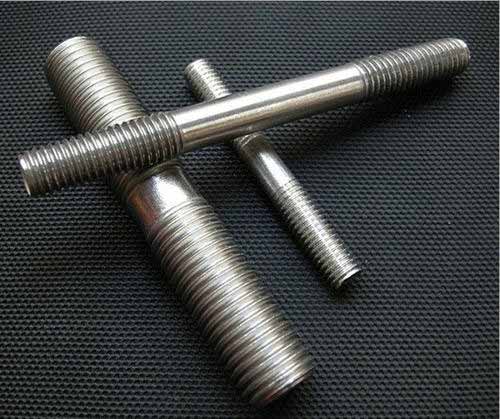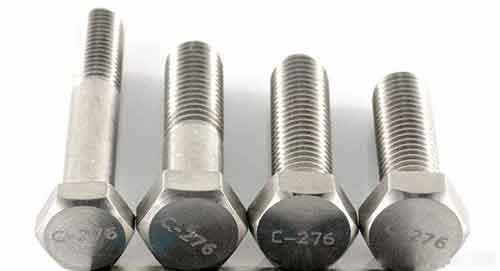Fastener material tips.(HY-industry technical centre)
1,Fastener material:Carbon steel
-
Carbon steel has excellent processability to meet a wide range of strength performance combinations and is less expensive to compare with other fastener materials.
-
The mechanical properties of carbon steel are very sensitive to carbon content, and the carbon content is usually less than 1.0%. For fasteners, there are three types of ordinary steel: low carbon steel, medium carbon steel and alloy steel.
2,Fastener material:Low-carbon steel
-
Low carbon steels usually have a carbon content of less than 0.25% and cannot be strengthened by heat treatment; strength can only be increased by cold work hardening. Low carbon steel is relatively soft and weak, but has excellent ductility and toughness. It also has easy processability and weldability, and relatively low production costs. For example, low carbon materials have a yield strength of 40,000 psi, a tensile strength of 60,000 to 80,000 psi, and a ductility of 25% EL. The most commonly used materials are the 1006, 1008, 1016, 1018, 1021 and 1022 grades specified by the AISI American Iron and Steel Institute standards.
-
The grades specified in the SAEJ 429 standard and the ASTM A 307 grade A are essentially the same and are the standard for low carbon steel strength grades. ASTM A 307 Grade B is a special low carbon steel grade for low carbon steel bolts on fittings and flanges. Its performance is basically the same as Grade A, except that it specifies a special maximum tensile strength. This is to ensure that once the over-tightening problem occurs during installation, the bolts will break before breaking the flanges, valves and pipes. SAE J 429 Grade 2 is a low carbon steel grade that has been cold hardened to increase strength.
3,Fastener material:medium carbon steel
-
The carbon content of medium carbon steel is 0.25~0.6% (mass fraction). Such steel can be improved in mechanical properties by heat treatment such as austenitizing, quenching and tempering. Ordinary medium carbon steel has poor hardenability and must be sufficiently cross-sectioned to be sufficiently hardened and quenched during quenching. This means that the final performance of the fastener depends on its size. Please note the SAE J 429 Grade 5, ASTM A325 and ASTM A 449 instructions for progressively “degrading” the strength properties as diameter increases.
-
From the ratio of strength to cost, the heat-treated medium carbon steel parts have excellent load carrying capacity, and have a low yield ratio; they also have good toughness. Commonly used materials are the 1030, 1035, 1038 and 1541 grades specified by the AISI American Iron and Steel Institute standards.
4,Fastener material:alloy steel
-
When the carbon content of carbon steel exceeds 1.65%, or the content of silicon or copper exceeds 0.6%, or the amount of chromium does not exceed 4%, it may be referred to as alloy steel. In addition, alloys are also referred to as carbon alloys with the addition of the specified minimum levels of ingredients such as aluminum, titanium, vanadium, nickel or other elements to achieve certain performance requirements. The addition of chromium, nickel and molybdenum can improve the material strength and ductility of the alloy steel after heat treatment.
-
SAEJ 429 grade 8, ASTM A 354 grade BD, ASTMA 490, ASTM A 193 B7 are all common alloy steel fasteners.
5,Fastener material:stainless steel
-
 Stainless steel is an iron-based alloy steel having a chromium content of more than 10.5%. The presence of chromium creates an invisible film on the steel surface that prevents oxidation and “passivates” or resists corrosion. Adding other elements such as nickel or molybdenum improves corrosion resistance, strength and temperature resistance.
Stainless steel is an iron-based alloy steel having a chromium content of more than 10.5%. The presence of chromium creates an invisible film on the steel surface that prevents oxidation and “passivates” or resists corrosion. Adding other elements such as nickel or molybdenum improves corrosion resistance, strength and temperature resistance. -
Stainless steel can be divided into three types according to its metallographic structure: austenite, martensite and ferrite. Each class has its own characteristics and is subdivided into several levels or types. Moreover, in order to adapt to different corrosion conditions, temperature range, strength requirements, welding performance, machining cutting performance, cold work hardening and forming ability, etc., new alloy steels can be further developed by changing the chemical composition.
Austenitic stainless steels have higher chromium and nickel content than other types of stainless steel. Austenitic stainless steel cannot be heat treated to increase hardness. But it has high corrosion resistance. Generally no magnetic; however, some parts may be slightly magnetic after the cold working process. The tensile strength of austenite is 75,000 to 105,000 psi.
18-8 stainless steel is a typical austenitic stainless steel type containing approximately 18% chromium and 8% nickel. 18-8 stainless steel includes 302, 303, 304 and XM7
Common austenitic stainless steel grade:
-
302: Commonly used stainless steel, the surface is matte color under normal atmospheric conditions, and still has high strength at a relatively high temperature. With corrosion resistance. After processing, it has high strength. Usually used as wire products, such as springs, screens, steel cables, etc. Also often used as a flat washer. ·
-
302HQ: Specially added copper reduces the effect of cold work hardening, making it easy to cold pier. Usually used for machine screws, metal screws and small nuts. ·
-
303: Contains a small amount of sulfur, has good machinability, and is often used to process non-standard bolts and nuts.
-
304: Low carbon and high chromium stainless steel, it has better corrosion resistance than 302. 304 is the most commonly used stainless steel for hexagon head bolts. It is usually processed by cold heading. It is also used for large diameter or long bolts. Way processing. ·
-
304L: The carbon content is lower than 304, so the strength is slightly lower. The low carbon content also gives it good corrosion resistance and weldability. ·
-
309 & 310: Nickel and chromium content are higher than the above several low grade steels, recommended for high temperature conditions. 310 has excellent corrosion resistance to salt water and other harsh environments. ·
-
316 and 317: Excellent resistance to seawater and various chemicals. Because it contains molybdenum, it is very resistant to surface pitting. Such steels have higher tensile strength and creep strength than other austenitic steels at elevated temperatures.
Limitations of austenitic stainless steel:
-
Only suitable for low concentrations of weak acids.
-
In the case of gaps and airtightness, there may not be enough oxygen to maintain the passivation film, which may cause crevice corrosion.
-
High concentrations of halide ions, especially chloride ions, can damage the passivation film.
After the heat treatment of the martensitic stainless steel, the metallographic structure is mainly martensite structure. This type of stainless steel contains 12 to 18% chromium. The hardness can be improved by heat treatment, and the welding performance is poor and magnetic. The tensile strength of martensitic stainless steel is about 70,000 to 145,000 psi. This type of stainless steel is suitable for use in low corrosive environments.
Common martensitic stainless steel grade:
· 410: Simple chrome alloy material, no nickel. It is a corrosion-resistant and heat-resistant chrome steel that can be hardened. It is easy to upset and has good machinability. Due to its high hardness, it is mainly used to manufacture self-drilling self-drilling screws. Compared with 300 series stainless steel, its corrosion resistance is quite poor.·
416: Similar to the 410 material except for a slightly higher chromium content, it has better machinability but is less resistant to corrosion than 410.The ferritic stainless steel contains 12% to 18% of chromium, but the carbon content is less than 0.2%. It is magnetic and cannot be hardened by heat treatment, and the welding performance is poor. Not suitable for use in highly corrosive environments.Common ferritic stainless steel grade:
· 430: slightly higher corrosion resistance than 410 stainless steel.
6,Fastener material:precipitation hardened stainless steel
-
Precipitation hardening stainless steel can be hardened after low temperature aging treatment and cold working. Type 630, also known as 17-4PH on the market, is the most used precipitation hardened stainless steel for fastener products. They have a very high tensile strength and flexibility. Therefore, its performance is quite good regardless of high temperature or low temperature.
7,Fastener material:nickel and high nickel alloy
-
 The nickel alloy family has some very good alloys. Strong mechanical properties, superior toughness and ductility, and resistance to stress corrosion. They have excellent corrosion resistance and workability at high temperatures and low temperatures. However, the price of nickel-based alloys is relatively expensive. Nickel alloys used in the fastener industry are nickel-copper alloys and nickel-copper alloys. Nickel-copper alloy, the market name is called monel alloy, monel 400 is the most widely used nickel-copper alloy for cold heading, showing very good corrosion resistance in heating or salt water. Nickel-copper-aluminum alloy, also known as K-MONEL on the market, is an extension of nickel-copper alloy. The aluminum and titanium elements increase the sensitivity of the heat treatment and significantly improve the mechanical properties.
The nickel alloy family has some very good alloys. Strong mechanical properties, superior toughness and ductility, and resistance to stress corrosion. They have excellent corrosion resistance and workability at high temperatures and low temperatures. However, the price of nickel-based alloys is relatively expensive. Nickel alloys used in the fastener industry are nickel-copper alloys and nickel-copper alloys. Nickel-copper alloy, the market name is called monel alloy, monel 400 is the most widely used nickel-copper alloy for cold heading, showing very good corrosion resistance in heating or salt water. Nickel-copper-aluminum alloy, also known as K-MONEL on the market, is an extension of nickel-copper alloy. The aluminum and titanium elements increase the sensitivity of the heat treatment and significantly improve the mechanical properties. -
Inconel nickel alloys and Hastelloy nickel alloys: These excellent materials provide the high strength and resistance to oxidation required by fasteners under extreme conditions such as high temperatures and different types of acidic environments.

